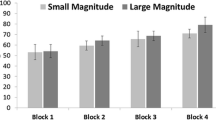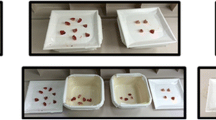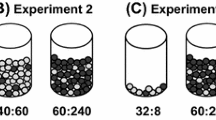Abstract
Nonhuman animals demonstrate a number of impressive quantitative skills such as counting sets of items, comparing sets on the basis of the number of items or amount of material, and even responding to simple arithmetic manipulations. In this experiment, capuchin monkeys were presented with a computerized task designed to assess conservation of discrete quantity. Monkeys first were trained to select from two horizontal arrays of stimuli the one with the larger number of items. On some trials, after a correct selection there was no feedback but instead an additional manipulation of one of those arrays. In some cases, this manipulation involved moving items closer together or farther apart to change the physical arrangement of the array but not the quantity of items in the array. In other cases, additional items were added to the initially smaller array so that it became quantitatively larger. Monkeys then made a second selection from the two arrays of items. Previous research had shown that rhesus monkeys (Macaca mulatta) succeeded with this task. However, there was no condition in that study in which items were added to the smaller array without increasing its quantity to a point where it became the new larger array. This new condition was added in the present experiment. Capuchin monkeys were sensitive to all of these manipulations, changing their selections when the manipulations changed which array contained the larger number of items but not when the manipulations changed the physical arrangement of items or increased the quantity in one array without also reversing which of the two arrays had more items. Therefore, capuchin monkeys responded on the basis of the quantity of items, and they were not distracted by non-quantitative manipulations of the arrays. The data indicate that capuchins are sensitive to simply arithmetic manipulations that involve addition of items to arrays and also that they can conserve quantity.


Similar content being viewed by others
References
Agrillo C, Dadda M, Bisazza A (2007) Quantity discrimination in female mosquitofish. Anim Cogn 10:63–70
Anderson JR, Awazu S, Fujita K (2000) Can squirrel monkeys (Saimiri sciureus) learn self-control: a study using food array selection tests and reverse-reward contingency. J Exp Psychol Anim Behav Proc 26:87–97
Anderson US, Stoinski TS, Bloomsmith MA, Marr MJ, Smith AD, Maple TS (2005) Relative numerousness judgment and summation in young and old Western Lowland gorillas. J Comp Psychol 119:285–295
Beran MJ (2001) Summation and numerousness judgments of sequentially presented sets of items by chimpanzees (Pan troglodytes). J Comp Psychol 115:181–191
Beran MJ (2004a) Long-term retention of the differential values of Arabic numerals by chimpanzees (Pan troglodytes). Anim Cogn 7:86–92
Beran MJ (2004b) Chimpanzees (Pan troglodytes) respond to nonvisible sets after one-by-one addition and removal of items. J Comp Psychol 118:25–36
Beran MJ (2007a) Rhesus monkeys (Macaca mulatta) succeed on a computerized test designed to assess conservation of discrete quantity. Anim Cogn 10:37–45
Beran MJ (2007b) Rhesus monkeys (Macaca mulatta) enumerate sequentially presented sets of items using analog numerical representations. J Exp Psychol Anim Behav Proc 33:42–54
Beran MJ, Beran MM (2004) Chimpanzees remember the results of one-by-one addition of food items to sets over extended time periods. Psychol Sci 15:94–99
Beran MJ, Rumbaugh DM (2001) “Constructive” enumeration by chimpanzees (Pan troglodytes) on a computerized task. Anim Cogn 4:81–89
Beran MJ, Klein ED, Evans TA, Chan B, Flemming TM, Harris EH, Wasburn DA, Rumbaugh DM (2007) Discrimination reversal learning in capuchin monkeys (Cebus apella). Psychol Rec (in press)
Boysen ST, Berntson GG (1989) Numerical competence in a chimpanzee (Pan troglodytes). J Comp Psychol 103:23–31
Biro D, Matsuzawa T (2001) Use of numerical symbols by the chimpanzee (Pan troglodytes) cardinals, ordinals, and the introduction of zero. Anim Cogn 4:193–199
Brannon EM, Terrace HS (2000) Representation of the numerosities 1–9 by rhesus macaques (Macaca mulatta). J Exp Psychol Anim Behav Proc 26:31–49
Brannon EM, Cantlon JF, Terrace HS (2006) The role of reference points in ordinal numerical comparisons by rhesus macaques (Macaca mulatta). J Exp Psychol Anim Behav Proc 32:120–134
Burns RA, Goettl ME, Burt ST (1995) Numerical discriminations with arrhythmic serial presentations. Psychol Rec 45:95–104
Call J (2000) Estimating and operating on discrete quantities in orangutans (Pongo pygmaeus). J Comp Psychol 114:136–147
Call J, Rochat P (1997) Perceptual strategies in the estimation of physical quantities by orangutans (Pongo pygmaeus). J Comp Psychol 111:315–329
Cantlon JF, Brannon EM (2006) Shared system for ordering small and large numbers in monkeys and humans. Psychol Sci 17:401–406
Capaldi EJ, Miller DJ (1988) Counting in rats: its functional significance and the independent cognitive processes that constitute it. J Exp Psychol Anim Behav Proc 14:3–17
D’Amato MR, Colombo M (1988) Representation of serial order in monkeys (Cebus apella). J Exp Psychol Anim Behav Proc 14:131–139
Davis H, Bradford SA (1986) Counting behavior by rats in a simulated natural environment. Ethology 73:265–280
De Lillo C, Visalberghi E (1994) Transfer index and mediational learning in tufted capuchins (Cebus apella). Int J Primatol 15:275–287
Evans TA, Westergaard GC (2004) Discrimination of functionally appropriate and inappropriate throwing tools by captive tufted capuchins (Cebus apella). Anim Cogn 7:255–262
Flombaum JI, Junge JA, Hauser MD (2005) Rhesus monkeys (Macaca mulatta) spontaneously compute addition operations over large numbers. Cognition 97:315–325
Gelman R (1972) The nature and development of early number concepts. In: Reese HW (ed) Advances in child development and behavior, vol 7. Academic, New York, pp 115–167
Hauser MD, MacNeilage P, Ware M (1996) Numerical representation in primates. Proc Natl Acad Sci 93:1514–1517
Hauser MD, Carey S, Hauser LB (2000) Spontaneous number representation in semi-free-ranging rhesus monkeys. Proc R Soc Lond B 267:829–833
Hauser MD, Dehaene S, Dehaene-Lambertz G, Patalano AL (2002) Spontaneous number discrimination of multi-format auditory stimuli in cotton-top tamarins (Saguinas oedipus). Cognition 86:B23–B32
Hauser MD, Tsao F, Garcia P, Spelke ES (2003) Evolutionary foundations of number: spontaneous representation of numerical magnitudes by cotton-top tamarins. Proc R Soc Lond B 270:1441–1446
Judge PG, Evans TA, Vyas DK (2005) Ordinal representation of numeric quantities by brown capuchin monkeys (Cebus apella). J Exp Psychol Anim Behav Proc 31:79–94
Matsuzawa T (1985) Use of numbers by a chimpanzee. Nature 315:57–59
McComb K, Packer C, Pusey A (1994) Roaring and numerical assessment in contests between groups of female lions, Panthera leo. Anim Behav 47:379–387
McGonigle B, Chalmers M, Dickinson A (2003) Concurrent disjoint and reciprocal classification by Cebus apella in seriation tasks: evidence for hierarchical organization. Anim Cogn 6:185–197
Mitchell RW, Yao P, Sherman PT, O’Regan M (1985) Discriminative responding of a dolphin (Tursiops truncatus) to differentially rewarded stimuli. J Comp Psychol 99:218–225
Muncer SJ (1983) “Conservations” with a chimpanzee. Dev Psychol 16:1–11
Olthof A, Iden CM, Roberts WA (1997) Judgments of ordinality and summation of number symbols by squirrel monkeys (Saimiri sciureus). J Exp Psychol Anim Behav Proc 23:325–339
Pepperberg IM (1994) Numerical competence in an African Grey parrot (Psittacus erithacus). J Comp Psychol 108:36–44
Pepperberg IM (2006) Gray parrot (Psittacus erithacus) numerical abilities: addition and further experiments on a zero-like concept. J Comp Psychol 120:1–11
Piaget J (1965) The child’s conception of number. Norton, New York
Reznikova ZI, Ryabko BY (1993) Ant aptitude for the transmission of information on the number of objects. In: Wiese K, Gribakin FG, Popov AV, Renninger G (eds) Sensory systems of arthropods. Birkhauser, Basel, pp 634–639
Richardson WK, Washburn DA, Hopkins WD, Savage-Rumbaugh ES, Rumbaugh DM (1990) The NASA/LRC computerized test system. Behav Res Methods Instrum Comput 22:127–131
Roberts WA, Coughlin R, Roberts S (2000) Pigeons flexibly time or count on cue. Psychol Sci 11:218–222
Rumbaugh DM (1970) Learning skills of anthropoids. In: Rosenblum (ed) Primate behavior: developments in field and laboratory research. Academic, New York, pp 1–70
Rumbaugh DM (1971) Evidence of qualitative differences in learning processes among primates. J Comp Physiol Psychol 76:250–255
Santos LR, Barnes JL, Mahajan N (2005) Expectations about numerical events in four lemur species Eulemur fulvus, Eulemur mongoz, Lemur catta, and Varecia rubra. Anim Cogn 8:253–262
Shumaker RW, Palkovich AM, Beck BB, Guagnano GA, Morowitz H (2001) Spontaneous use of magnitude discrimination and ordination by the orangutan (Pongo pygmaeus). J Comp Psychol 115:385–391
Smith BR, Piel AK, Candland DK (2003) Numerity of a socially housed hamadryas baboon (Papio hamadryas) and a socially housed squirrel monkey (Saimiri sciureus). J Comp Psychol 117:217–225
Suda C, Call J (2004) Piagetian liquid conservation in the great apes (Pan paniscus, Pan troglodytes, and Pongo pygmaeus). J Comp Psychol 118:265–279
Suda C, Call J (2005) Piagetian conservation of discrete quantities in bonobos (Pan paniscus), chimpanzees (Pan troglodytes), and orangutans (Pongo pygaeus). Anim Cogn 8:220–235
Suda C, Call J (2006). What does an intermediate success rate mean? An analysis of a Piagetian liquid conservation task in the great apes. Cognition 99:53–71
Terrell DF, Thomas RK (1990). Number-related discrimination and summation by squirrel monkeys (Saimiri sciureus sciureus and S. boliviensus boliviensus) on the basis of the number of sides of polygons. J Comp Psychol 104:238–247
Thomas RK, Chase L (1980) Relative numerousness judgments by squirrel monkeys. Bull Psychon Soc 16:79–82
Thomas RK, Peay L (1976) Length judgments by squirrel monkeys: evidence for conservation? Dev Psychol 12:349–352
Thomas RK, Walden EL (1985) The assessment of cognitive development in human and nonhuman primates. In: Watts ES (eds) Nonhuman primate models for human growth and development. Alan R. Liss Inc., New York, pp 187–215
Uller C, Hauser MD, Carey S (2001) Spontaneous representation of number in cotton-top tamarins (Saguinus oedipus). J Comp Psychol 115:248–257
Uller C, Jaeger R, Guidry G, Martin C (2003) Salamanders (Plethodon cinereus) go for more: rudiments of number in an amphibian. Anim Cogn 6:105–112
vanMarle K, Aw J, McCrink K, Santos LA (2006) How capuchin monkeys (Cebus apella) quantify objects and substances. J Comp Psychol 120:416–426
Visalberghi E, Fragaszy DM, Savage-Rumbaugh ES (1995) Performance in a tool-using task by common chimpanzees (Pan troglodytes), bonobos (Pan paniscus), an orangutan (Pongo pygmaeus), and capuchin monkyes (Cebus apella). J Comp Psychol 109:52–60
Ward C, Smuts BB (2007) Quantity-based judgments in the domestic dog (Canis lupus familiaris). Anim Cogn 10:71–80
Washburn DA, Hopkins WD, Rumbaugh DM (1989) Video-task assessment of learning and memory in macaques (Macaca mulatta): effects of stimulus movement on performance. J Exp Psychol Anim Behav Proc 15:393–400
West RE, Young RJ (2002) Do domestic dogs show any evidence of being able to count? Anim Cogn 5:183–186
Woodruff G, Premack D, Kennel K (1978) Conservation of liquid and solid quantity by the chimpanzee. Science 202:991–994
Wright AA (1999) Visual list memory in capuchin monkeys (Cebus apella). J Comp Psychol 113:74–80
Xia L, Emmerton J, Siemann M, Delius JD (2001) Pigeons (Columba livia) learn to link numerosities with symbols. J Comp Psychol 115:83–91
Acknowledgments
This research was supported by National Institutes of Health Grant HD - 38051 and by Grant BCS-0634662 from the National Science Foundation.
All applicable institutional rules and regulations regarding animal care and use have been followed in the care and testing of the monkeys, and the experiment complied with all laws of the United States of America. The author thanks Theodore Evans, Emily Klein, and Betty Chan for their assistance with data collection.
Author information
Authors and Affiliations
Corresponding author
Rights and permissions
About this article
Cite this article
Beran, M.J. Capuchin monkeys (Cebus apella) succeed in a test of quantity conservation. Anim Cogn 11, 109–116 (2008). https://doi.org/10.1007/s10071-007-0094-3
Received:
Revised:
Accepted:
Published:
Issue Date:
DOI: https://doi.org/10.1007/s10071-007-0094-3




